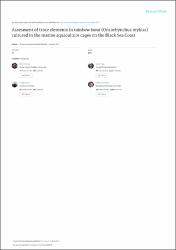| dc.contributor.author | Verep, Bülent | |
| dc.contributor.author | Akın, Şenol | |
| dc.contributor.author | Mutlu, Cengiz | |
| dc.contributor.author | Apaydın, Gökhan | |
| dc.contributor.author | Ertuğral, Birol | |
| dc.contributor.author | Çevik, Uğur | |
| dc.date.accessioned | 2020-12-19T20:13:01Z | |
| dc.date.available | 2020-12-19T20:13:01Z | |
| dc.date.issued | 2007 | |
| dc.identifier.citation | Verep, B., Akın, Ş., Mutlu, C., Apaydın, G., Ertuğrul, B. & Çevik, U. (2007). Assesment of trace elements in rainbow trout (Oncorhynchus mykiss) cultured in the marine aquaculture cages on the Black Sea Coast. Fresenius Environmental Bulletin, 16(9A), 1005-1011. | en_US |
| dc.identifier.issn | 1018-4619 | |
| dc.identifier.uri | https://hdl.handle.net/11436/3961 | |
| dc.description.abstract | The concentrations of trace elements were determined in various tissues (internal organs, liver, abdominal and dorsal muscle) of individuals of cultured fishes obtained from two marine cage farms located on the coasts of Rize, Turkey. The concentrations of seven trace elements (sulphur (S), chloride (Cl), potassium (K), calcium (Ca), iron (Fe), barium (Ba), and tin (Sn) were determined in ten specimens (5 from each farm) using energy dispersive X-ray fluorescence method. A radioisotope excited X-ray fluorescence analysis using the method of multiple standard additions is applied for the elemental analysis of fish. The results obtained from these analyses showed similar patterns of distribution among farms and organs. The averages of trace elements did not statistically differ among farms, but did differ among the organs. Regardless of organs, K (1.64 %) was the highest followed by Cl (1.64 %), Fe (0.57 %), S (0.48 %), and Ca (0.20 %). The other trace elements (Sn and Ba) regarded as heavy metals with Fe had the lowest concentrations in fish. The results also showed that the liver accumulated the highest concentrations of all elements combined (0.48 %) followed by dorsal and abdominal muscle, and interior organs. Concentrations of K (2.35 %), Cl (2.27 %), S (1.22 %), and Fe (0.85 %) in liver were much higher than the concentrations of the other elements. Accumulations of Sn and Ba as heavy metals, on the other hand, were the lowest in liver with averages of 0.03 ?gg-1 and 0.00 ?gg-1, respectively. Despite the variability in concentrations of the heavy elements, concentrations of those elements in the tissue samples are not higher than the toxic level. © by PSP 2007. | en_US |
| dc.language.iso | eng | en_US |
| dc.rights | info:eu-repo/semantics/openAccess | en_US |
| dc.subject | Aquaculture | en_US |
| dc.subject | Freshwater fish | en_US |
| dc.subject | Heavy metals | en_US |
| dc.subject | Rainbow trout | en_US |
| dc.subject | Trace elements | en_US |
| dc.title | Assesment of trace elements in rainbow trout (Oncorhynchus mykiss) cultured in the marine aquaculture cages on the Black Sea Coast | en_US |
| dc.type | article | en_US |
| dc.contributor.department | RTEÜ, Su Ürünleri Fakültesi, Su Ürünleri Temel Bilimler Bölümü | en_US |
| dc.contributor.institutionauthor | Verep, Bülent | |
| dc.identifier.volume | 16 | en_US |
| dc.identifier.issue | 9:00 AM | en_US |
| dc.identifier.startpage | 1005 | en_US |
| dc.identifier.endpage | 1011 | en_US |
| dc.relation.journal | Fresenius Environmental Bulletin | en_US |
| dc.relation.publicationcategory | Makale - Uluslararası Hakemli Dergi - Kurum Öğretim Elemanı | en_US |


















